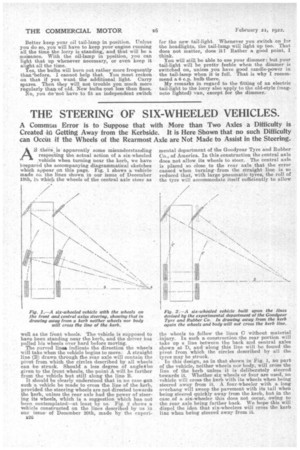THE STEERING OF SIX-WHEELED VEHICLES.
Page 26

If you've noticed an error in this article please click here to report it so we can fix it.
A Common Error is to Suppose that with More than Two Axles a Difficulty is Created lu Gettifig Away from the Kerbside. It is Here Shown that no such Difficulty can Occui if the Wheels of the Rearmost Axle are Not Made to Assist in the Steering.
S ere is apparently some misunderstanding A th ._
respecting the actual action of a six-wheeled vehicle when turning near the kerb, we have leepared the accompanying diagrammatical sketches which appear on this page. Fig. 1 shows a vehicle made on the lines shown in our issue of December 13th, lei which the wheels of the central axle steer as . : well as the front wheels. The vehicle is supposed to have been standing near the kerb, and the driver has pulled his wheels over hard before moving. The curved lines indicate the direction the wheels will take when the vehicle begins to move. A straight line (B) drawn through the rear axle will contain the pivot from which the circles described by all wheels can be struck. Should a less degree of angletbe given to the front wheels, the point A will be farther from the vehicle but still along the line B.
It should be clearly understood that in no case van such a vehicle be made to cross the line of the kerb, provided the steering wheels are not directed towards the kerb, unless the rear axle had the power of steering its wheels, which is a suggestion which has not been contemplated—at least by us. Fig. 2 shows a vehicle constructed on the lines described by us in our issue. of December 20th, made by the experi
226 mental department of the Goodyear Tyre and Rubber Co., of America. In this construction the central axle does not allow, its wheels to steer. The central axle is placed so close to the rear axle that the error caused when turning. from the straight line is so reduced that, with large pneumatic tyres, the roll of the tyre will accommodate itself sufficiently to allow the wheels to follow the lines C without material .injury. In such a construction the rear portion will take up a line between the back and central axles shown at D, and along this line will be found the pivot, from which the circles described by all thetyres may be struck.
. In this design, as in that shown in Fig. 1, no part of the vehicle, neither wheels nor body, will cross the line of the kerb unless it is deliberately steered towards it. Whether six wheels or four are used, no vehicle will cross the kerb with its wheels when being steered away from it. A four-wheeler with a long overhang will sweep the pavement with its tail when being steered quickly away from the kerb, but in the caseeof a six-wheeler this does not occur, owing to the rear axle being farther back. We hope this will dispel the idea that six-wheelers will cross the kerb line when being steered away from it.






























